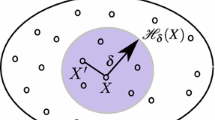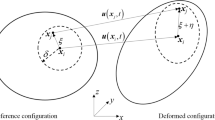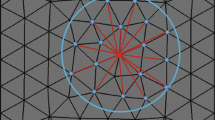Abstract
The primary mechanism of damage evolution of brittle materials in peridynamic theory is based on individual pair-wise bond strain. A critical value for bond strain is derived based on linear elastic fracture mechanic theory. It is a function of the horizon, the radius of non-locality of the material. The horizon must be larger than the material point spacing but not too large which would significantly slow the simulation. Typical sizes used for the horizon range between three and six times the material point spacing, if a constant multiple is used it could be said that the critical strain is a function of the model’s material point grid resolution. This critical strain function ensures that the fracture toughness is independent of the horizon and grid resolution. This works well when modeled materials have pre-existing cracks. However, since the peridynamic fracture toughness manifests as a critical strain it imposes an artificial strength onto the modeled material that may not represent the real strength of the material. When the material strength is less than the model’s critical strain certain flaw insertion methods can be used to capture the strength behavior. However, if the material strength is larger than the critical strain then the flaw size that represents that strength is too small to model. To address this discrepancy, multi-resolution models have been previously used, having differently sized horizons, such that the region that is expected to nucleate failure is represented correctly while the bulk material is modeled with a coarser grid and larger horizon. Such a multiscale approach could be designed from the beginning of the simulation or exhibit adaptive refinement during crack propagation. Such multiscale approaches add significant complexity to the simulation framework and fundamental model descriptions. This paper introduces a method that is able to decouple the model strength from the horizon and grid resolution by using a refinement overlay technique. This overlay is virtual and does not change the explicit material resolution as adaptive techniques do.










Similar content being viewed by others
References
Ohsugi S, Yoshioka S, Miyazaki M, Itoh J, Tani S, Nakamura K, Hijikata A (1998) Statistical properties on mechanical strength of glass for cathode ray tubes. J Soc Mater Sci Jpn 47(10):1071–1076. https://doi.org/10.2472/jsms.47.1071
Veer FA, Rodichev YM (2011) The structural strength of glass: hidden damage. Strength Mater 43(3):302. https://doi.org/10.1007/s11223-011-9298-5
Anderson TL (2005) Fracture mechanics: fundamentals and applications, 3rd edn. Taylor & Francis, New York
Bartenev GM, Sidorov AB (1966) Statistical theory of the strength of glass fibers. Polymer Mech 2(1):52–56. https://doi.org/10.1007/BF01198443
Dassault Systems Simulia Corp., USA. ABAQUS/CAE 6.13 documentation (2011)
Park K, Choi H, Paulino GH (2016) Assessment of cohesive traction-separation relationships in ABAQUS: a comparative study. Mech Res Commun 78:71–78
Stuparu FA, Apostol DA, et al. (2016) Cohesive and XFEM evaluation of adhesive failure for dissimilar single-lap joints. Procedia Struct Integr 2:316–325
Rabczuk T (2013) Computational methods for fracture in brittle and quasi-brittle solids: state-of-the-art review and future perspectives. ISRN Appl Math 849231:1–38
Bobaru F, Zhang G (2015) Why do cracks branch? A peridynamic investigation of dynamic brittle fracture. Int J Fract 196(1): 59–98. https://doi.org/10.1007/s10704-015-0056-8
Yoffe EH (1951) The moving Griffith crack. Philos Mag 42:739–750. https://doi.org/10.1080/14786445108561302
Silling SA (2000) Reformulation of elasticity theory for discontinuities and long-range forces. J Mech Phys Solids 48(1):175–209
Gerstle W, Sau N, Silling S (2005) Peridynamic modeling of plain and reinforced concrete structures. In: 18th International conference on structural mechanics in reactor technology (SMiRT 18) SMiRT18-B01-2
Dipasquale D, Zaccariotto M, Galvanetto U (2014) Crack propagation with adaptive grid refinement in 2D peridynamics. Int J Fract 190(1):1–22. https://doi.org/10.1007/s10704-014-9970-4
Silling S, Askari E (2005) A meshfree method based on the peridynamic model of solid mechanics. Comput Struct 83(17):1526–1535. https://doi.org/10.1016/j.compstruc.2004.11.026. Advances in Meshfree Methods
Ha YD, Bobaru F (2010) Studies of dynamic crack propagation and crack branching with peridynamics. Int J Fract 162:229–244
Silling SA, Weckner O, Askari E, Bobaru F (2010) Crack nucleation in a peridynamic solid. Int J Fract 162(1):219–227. https://doi.org/10.1007/s10704-010-9447-z
Das S, Hoffarth C, Ren B, Spencer B, Sant G, Rajan SD, Neithalath N (2019) Simulating the fracture of notched mortar beams through extended finite element method (XFEM) and peridynamics. J Eng Mech. https://doi.org/10.1061/(ASCE)EM.1943-7889.0001628
Bobaru F, Hu W (2012) The meaning, selection, and use of the peridynamic horizon and its relation to crack branching in brittle materials. Int J Fract 176(2):215–222. https://doi.org/10.1007/s10704-012-9725-z
Tanguy A (2015) Vibration modes and characteristic length scales in amorphous materials. JOM 67(8):1832–1839. https://doi.org/10.1007/s11837-015-1480-y
Dipasquale D, Sarego G, Zaccariotto M, Galvanetto U (2016) Dependence of crack paths on the orientation of regular 2D peridynamic grids. Eng Fract Mech 160:248–263. https://doi.org/10.1016/j.engfracmech.2016.03.022
Dipasquale D, Sarego G, Zaccariotto M, Galvanetto U (2017) A discussion on failure criteria for ordinary state-based peridynamics. Eng Fract Mech 186:378–398. https://doi.org/10.1016/j.engfracmech.2017.10.011
Gerstle W, Sau N, Silling S (2007) Peridynamic modeling of concrete structures. Nuclear Eng Des 237 (12):1250–1258
Zhang H, Qiao P (2018) A coupled peridynamic strength and fracture criterion for open-hole failure analysis of plates under tensile load. Eng Fract Mech 204:103–118. https://doi.org/10.1016/j.engfracmech.2018.09.037
Macrelli G (2018) Chemically strengthened glass by ion exchange: Strength evaluation. Int J Appl Glas Sci 9 (2):156–166. https://doi.org/10.1111/ijag.12291
Veer FA, Louter PC, Bos FP (2009) The strength of annealed, heat-strengthened and fully tempered float glass. Fatigue Fract Eng Mater Struct 32(1):18–25. https://doi.org/10.1111/j.1460-2695.2008.01308.x
Jeon B, Stewart RJ, Ahmed IZ (2015) Peridynamic simulations of brittle structures with thermal residual deformation: strengthening and structural reactivity of glasses under impacts. Proc R Soc A: Math Phys Eng Sci 471(2183):20150231. https://doi.org/10.1098/rspa.2015.0231
Reddy JN (2006) Introduction to the finite element method, 3rd edn. McGraw-Hill Education
Bobaru F, Ha YD (2011) Adaptive refinement and multiscale modeling in 2D peridynamics. J Multiscale Comput Eng 9(6): 635–659
Shojaei A, Mossaiby F, Zaccariotto M, Galvanetto U (2018) An adaptive multi-grid peridynamic method for dynamic fracture analysis. Int J Mech Sci 144:600–617. https://doi.org/10.1016/j.ijmecsci.2018.06.020
Fan J (2010) Multiscale analysis of deformation and failure of materials. Wiley
Fan J (2009) Multiscale analysis across atoms/continuum by a generalized particle dynamics method. Multiscale Model Simul 8(1):228–253
Fan J, Stewart R, Zeng X (2011) A multiscale method for dislocation nucleation and seamlessly passing scale boundaries. Int J Plast 27:2103–2124
Farrell DE, Park HS, Liu WK (2007) Implementation aspects of the bridging scale method and application to intersonic crack propagation. Int J Numer Meth Eng 71:583–605
Fan J, Stewart R, Xu T (2017) Simulation accuracy of crack-tip parameters with extended GP methods. Eng Fract Mech 170:87–106. https://doi.org/10.1016/j.engfracmech.2016.11.035
Costa T, Bond S, Littlewood D (2018) Nonlocal and mixed-locality multiscale finite element methods. Multiscale Model Simul 16(1):503–527. https://doi.org/10.1137/16M1090351
Zaccariotto M, Mudric T, Tomasi D, Shojaei A, Galvanetto U (2018) Coupling of FEM meshes with peridynamic grids. Comput Methods Appl Mech Eng 330:471–497. https://doi.org/10.1016/j.cma.2017.11.011
Miller RE, Tadmor EB (2009) A unified framework and performance benchmark of fourteen multiscale atomistic/continuum coupling methods. Model Sim Mat Sci Eng 17
Bazănt ZP (1978) Spurious reflection of elastic waves in nonuniform finite element grids. Comput Methods Appl Mech Eng 16(1):91–100. https://doi.org/10.1016/0045-7825(78)90035-X
Celep Z, Bazănt ZP (1983) Spurious reflection of elastic waves due to gradually changing FE size. Int J Numer Methods Eng 19:631–646. https://doi.org/10.1002/nme.1620190503
Madenci E, Barut A, Futch M (2016) Peridynamic differential operator and its applications. Comput Methods Appl Mech Eng 304:408–451
Shojaei A, Galvanetto U, Rabczuk T, Jenabi A, Zaccariotto M (2019) A generalized finite difference method based on the Peridynamic differential operator for the solution of problems in bounded and unbounded domains. Comput Methods Appl Mech Eng 343:100–126. https://doi.org/10.1016/j.cma.2018.08.033
Madenci E, Oterkus E (2014) Peridynamic theory and its applications. Springer
Acknowledgements
The authors thank Jason Harris for being supportive of this work and for guiding discussions, as well as Wei Xu and Sam Zoubi for enthusiastic support.
Author information
Authors and Affiliations
Corresponding author
Rights and permissions
About this article
Cite this article
Stewart, R.J., Jeon, B. Decoupling Strength and Grid Resolution in Peridynamic Theory. J Peridyn Nonlocal Model 1, 97–106 (2019). https://doi.org/10.1007/s42102-019-00008-8
Received:
Accepted:
Published:
Issue Date:
DOI: https://doi.org/10.1007/s42102-019-00008-8




